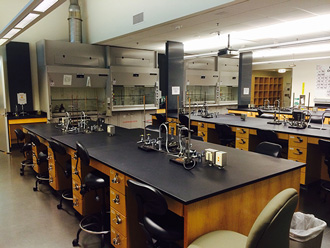Energy Upgrades Overcome Scheduling Challenges, Produce Verified Savings
Completing the energy upgrades required attention to detail, from scheduling to measures to verify savings.
Once the investigation was complete and reviewed by the utilities, a detailed project scope of work needed to be developed for the college to use as the basis for a “Request for Proposal” (RFP). As required by the California Clean Energy Jobs Act (Proposition 39), which makes funding available to eligible projects to improve energy efficiency and expand clean energy generation, no sole sourcing of project implementation was allowed. The final procurement process, however, was up to Santiago Canyon College. After reviewing the scope of work and assessing the project’s complexity, the college opted for a “Best Value” bidding process.

The exhaust hood control system for lab classrooms in the Science Center at Santiago Canyon College was integrated with a new open protocol building control system.
Because Proposition 39 funding carries a specific annual completion schedule, this project order had to be completed within 120 days to qualify for available state funds. As a result, the project was planned to expedite the long lead-time items and implement a three-week look-ahead schedule.
The Science Building classroom schedule also presented a challenge. Both the college classrooms and lab rooms were in full session, so work had to be arranged to avoid any interruption to ongoing operations. Teams worked nights and weekends when the labs were not in use.
A decision was made at the outset to replace the existing legacy control system rather than upgrade it to achieve the new, more efficient sequences of building operation. A new open protocol control system was selected and integrated with the lab exhaust hood control system. This integration was critical to bring the lab exhaust fans under control and have them cooperate with the overall building supply and exhaust fans. In fact, student safety, not just energy efficiency, hung in the balance. Integration made it possible to eliminate excessive negative static pressure, which was one of the original problems with the building. More specifically, students found it difficult, if not impossible, to exit rooms due to excessive negative pressure in the building, particularly when the supply fans would normally be turned off or if a fire were to occur. The fire marshal noticed this problem during the original fire/life-safety inspection and mandated that the supply fans run 24/7 to minimize the effects of this problem; the building had been operating like this for several years until the retrocommissioning efforts.
Additionally, the new control system had to be installed while still keeping the old system online. This process required shutdowns during turnover of the old controls to the new controls. All scheduled shutdowns had to be up and running by 5:00 a.m. each day.
Verifying Payback
At completion of the project, the actual energy calculations had to be verified. This was done using the data loggers and establishing trends on the new building automation system. The actual savings results of the project include:
Projected kWh Savings: 429,959 kWh
Actual verified kWh Savings: 399,317 kWh - 92.8 percent of goal
Projected Natural Gas Therm Savings: 21,429 therms
Actual Natural Gas Therm Savings: 20,686 therms – 96.5 percent of goal
All actual savings reports were verified using a combination of campus energy management system trending and installed date loggers trends. All savings were reviewed and approved by an energy engineering firm, on behalf of Southern California Edison and Southern California Gas.
The combined annual utility savings came to $64,319. On top of that, the project earned a CCC/IOU Partnership incentive of $134,611. The project cost of all energy conservation measures totaled $459,933, for a simple payback of 5.05 years
Lance English is a Sales Manager for Southland Industries, a national MEP building systems firm. Mr. English has more than 35 years of facility, design, operation, and retrocommissioning experience, and specializes in multiyear/integrated agreements, retrofits, retrocommissioning, and energy savings. Southland Industries partnered with the Rancho Santiago Community College District to conduct the retrocommissioning engineering review, analyzed energy efficiency options, developed the building energy model, planned the schedule and integrated the control system. He can be reached at lenglish@southlandind.com.
Related Topics:













